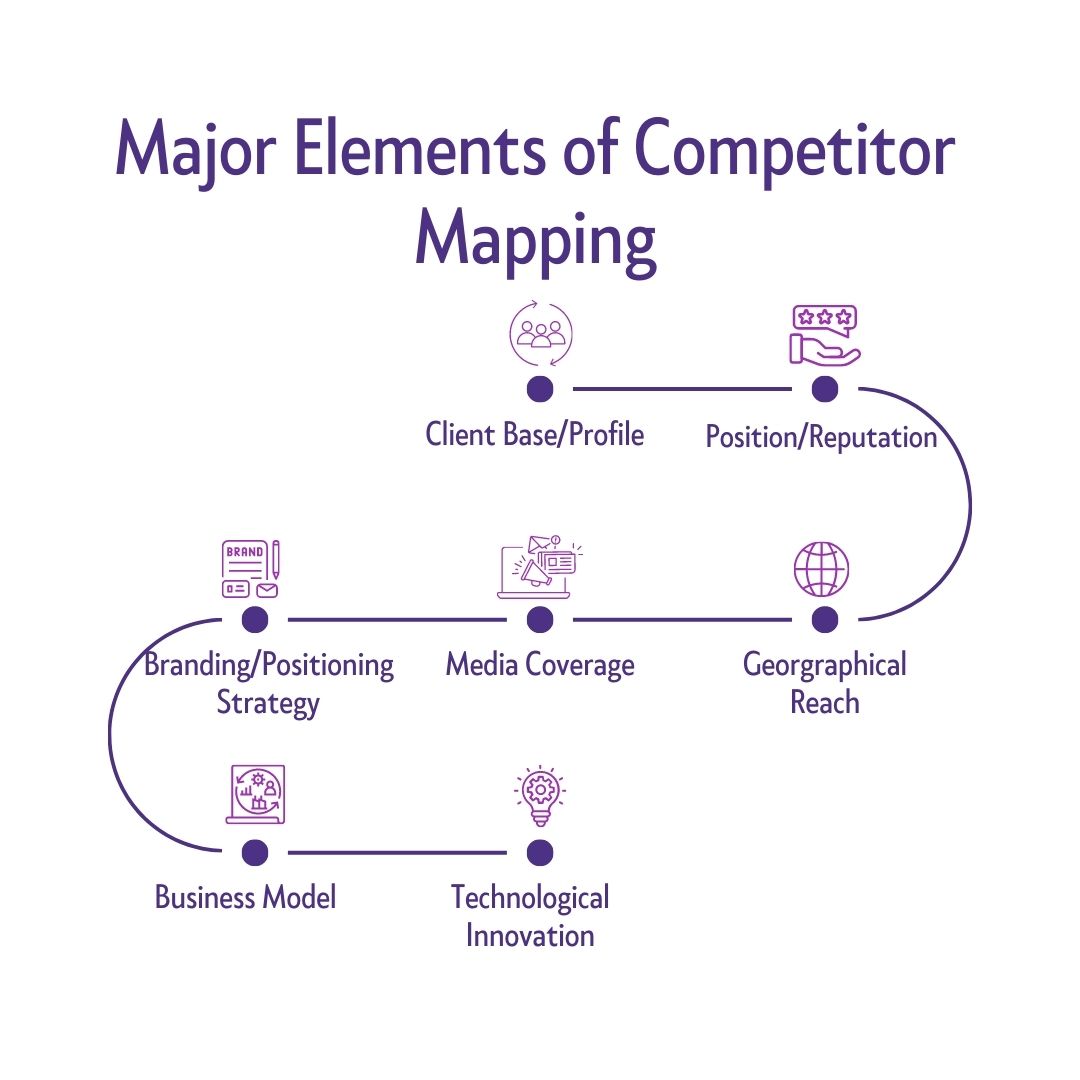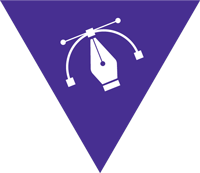
Q. WHAT IS COMPETITOR MAPPING AND ITS PURPOSE?
A Competitor Mapping is the systematic method to identify and analyse the competitors of an organisation (law firms in our case) within a specific industry.
The first step towards competitor mapping is identifying competitors with a competitive advantage and performing better on the analysis metrics.
The purpose of competitor mapping is to analyse the gathered comprehensive data and understand the competitive environment, allowing law firms to make informed decisions, improve their strategies, and uncover potential opportunities for differentiation and growth. It is an essential method for legal marketing companies in India to trace the competitors in order to give valuable and growth-oriented advice to law firms seeking growth and building their brands.
Q. HOW TO APPROACH IDENTIFYING AND CATEGORISING KEY COMPETITORS WITHIN THE LEGAL INDUSTRY?
A. Identifying and categorising key competitors within the legal industry requires a methodical and systematic approach.
Look for peer law firms that match the parameters of the law firm for which the analysis is being done. Here, the parameters can range from the number of lawyers in the firm, total years of establishment, number of partners, key practice areas, client base, position in the legal market, geographic reach, reputation, and many more. If all these parameters of the competitors match or fall into some nearby category of the law firm, then those competitors are worth the analysis. Further, filter the competitors based on their competitive advantage over the law firm.
Further, to gather information about the competitors, analyse their social media platforms and branding tools, including their branding & positioning strategy, specialised activation scope, publications, ranking, client portfolio, business model, and so on. Organise and structure this information in a manner that is visually easier to comprehend and answers the question, ‘Why is it a competitor?’.
Later, categorise the competitors based on various factors, including their type, assessing their technological adoption, pricing strategies, and client engagement methods.
Lastly, compare the competitors with the law firm and structure the information in an easy-to-understand manner.
Q. WHAT ARE THE MOST CRUCIAL ELEMENTS TO CONSIDER WHEN CONDUCTING A THOROUGH ANALYSIS OF A LAW FIRM’S COMPETITORS?
A. The most vital elements that legal marketing companies in India should keep in mind to analyse the law firms’ competitors are:

1. Client Base/Profile: It is crucial to understand the type of clients the competitor is catering to as it gives an idea of the length and breadth of services they are providing, the industries they are serving, and whether they are focused on the number of clients or the quality of clients. A legal marketing consultant can help you in conducting a comprehensive competitor analysis to help your law firm gain a competitive edge in the legal industry.
2. Position in the Market/Reputation: The position and reputation of a competitor can very well be analysed by examining the track records of wins and case outcomes, recognitions by the ranking platforms, and the accolades received. With this, it is also essential to analyse whether the competitor is ranked/recognized by a well-known platform or not, as it gives a clear picture of their stand and status within the market.
3. Geographical Reach: Evaluating geographical reach helps understand the client coverage of the competitors and predict their possibility of penetration and growth within a particular jurisdiction. It gives a better picture of the potential target clients for the law firm.
4. Media Coverage: If the competitors are featured on the media platforms for their case win, recognitions and accolades, firm growth or other value-adding action in the legal market, it is helpful to analyse such data to understand their outreach and value in the legal market.
5. Branding and positioning strategy: Studying and analysing data about competitor’s online presence, messaging & branding identity, target audience, unique value proposition, type of content created, publications, networking strategies including specialised activation scope, participation in events/conferences, knowledge management, designing and so on, helps in understanding their future branding prospects.
6. Business Model: Identifying the competitors’ business model gives a clear picture of the competitor’s future growth strategy and scope of growth. It further helps the law firm make informed decisions and strategies for their development.
7. Technological Innovation: In the age of LegalTech, it is crucial to explore technologies valuable for a law firm practice, which can easily be done by analysing the technologies used by the competitors.
Q. HOW CAN THE INFORMATION GATHERED ABOUT COMPETITORS BE KEPT RELEVANT AND TAILORED TO THE SPECIFIC MARKET SEGMENT/PRACTICE AREA/INDUSTRY THE FIRM AIMS TO TARGET?
A. To ensure that the gathered competitor information is relevant and tailored to specific market segments that the firm aims to target, focus on doing the market research concerning that particular market or industry needs and preferences of services, which helps in categorising the competitors that provide such services. This also helps the law firm tailor their services to address the specific concerns, needs, and priorities of the market or that particular industry.
Ensure to highlight the aspects where the law firm outperforms the competitors and also the segments where the firm has scope for improvement compared to the competitors. Hence, this gives a comparative advantage or edge over the competitors.
Q. WHAT ARE THE ETHICAL CONSIDERATIONS WHILE CONDUCTING COMPETITOR MAPPING AND ANALYSIS, PARTICULARLY WITHIN THE LEGAL CONTEXT?
A. The primary ethical considerations while doing competitor mapping within the legal industry include ensuring not to infringe the data privacy of the competitors, which means when collecting the data of the competitors for analysis, data protection regulations are complied with. Apart from that, it is a good ethical practice to avoid accessing confidential data and instead use the data on record only for analysis.
It is vital to keep the information accurate and as is without misleading and misrepresenting it to maintain the integrity and authenticity of the data intact.
Most importantly, ensure not to engage in any activity that harms the competitors and avoid unfair practices in gathering information at any given point.
Q. COMPETITOR MAPPING AND ANALYSIS EFFORTS CAN SIGNIFICANTLY IMPROVE A LAW FIRM’S BRANDING STRATEGY AND OVERALL MARKET POSITIONING. HOW?
A. Competitor mapping helps identify better approaches and directions for a firm’s growth.
To do so, the legal marketing companies in India often create a brand story of the law firm that differentiates it from the rest, identifies the scopes of improvement, and creates unique selling values for its target market segment/clientele.
Further, tailoring the firm’s message by emphasising its strengths and advantages compared to the competitors helps create a value proposition in the eyes of the target clientele and benefits in building the trust factor.
Crafting the firm’s approach and strategies in a manner that aligns with the client’s needs and preferences is unique, as it showcases the value-adding capacity and solution-oriented approach of the firm. Improvising strategies based on insights gained from data analysis of the competitors is a significant step towards improving the law firm’s branding strategy.
 We hope you found the above information helpful to your firm’s branding strategy! If you are looking for any support or guidance, we are standing by to assist you! Feel free to reach out to us!
We hope you found the above information helpful to your firm’s branding strategy! If you are looking for any support or guidance, we are standing by to assist you! Feel free to reach out to us!








